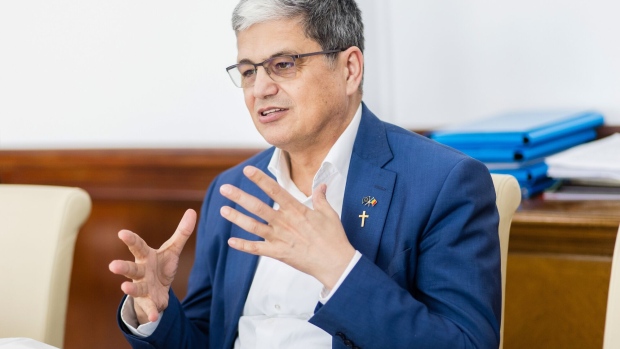Feb 20, 2024
Romania May Need the Rest of the Decade to Reduce Budget Deficit
, Bloomberg News

(Bloomberg) -- Romania may need until the end of the decade to bring its budget deficit down to a target set by European Union rules as the government contends with public resistance to fiscal restraint in an election year.
Finance Minister Marcel Bolos said a regime of annual budget cuts amounting to 0.5% of gross domestic product under the EU’s new fiscal rules presents a “very hard” challenge. The Black Sea nation likely needs the seven years allotted by the fiscal framework to narrow the gap to 3% of GDP from 5% forecast for this year — a slower pace than originally projected.
“I simply don’t know if a bigger adjustment is even possible for us,” Bolos said in an interview from his office in Bucharest on Monday. “It’s an election year and spending cuts are a very sensitive topic in our country,” Bolos said.
Prime Minister Marcel Ciolacu’s government approved two pension increases this year as well as higher wages for teachers — and may face pressure from state health-care workers and police, adding to spending. Still, Bolos said tax revenue will be abetted this year with measures to fight tax fraud and adapting revenue collection to digital technology.
Even the seven-year budget horizon depends on whether credit-rating agencies regard electoral spending as sustainable and withhold potential downgrades. While the EU introduced flexibility with its fiscal rules, rating agencies may not show such leniency if spending plans are unveiled without a clear revenue picture, Bolos said.
‘Strong Points’
Romania, which has been under the EU’s excessive deficit procedure since before the pandemic, has the lowest investment grade with a stable outlook at all three major rating companies. Fitch Ratings is scheduled to review Romania as early as next week.
Read More: Rating Firms See Romanian Pension Law as Negative on Credit
“We had talks with rating agencies and they warned us about public spending increases in the wider context of the electoral year,” Bolos said. “I urged them to also consider Romania’s strong points compared with similarly-rated peers, such as the high level of investments and low public debt.”
Another element still working in Romania’s favor is the access to funding, which hasn’t been a major problem, despite the country having to pay higher costs to borrow than most of its regional peers.
The nation has almost met all of its foreign debt sale plans for this year after raising about $8.3 billion on the market. Part of that amount includes the nation’s first green bond issued last week.
The proceeds of about €2 billion ($2.2 billion) will be used to finance environmentally-friendly projects such as new train and subway lines. More green bond sales will likely follow on the domestic market as well, Bolos said.
“Romania remains a very attractive issuer for investors, though unfortunately for us, at pretty high costs,” Bolos said.
To also help finance th deficit, the government will continue to apply a 90% dividend-distribution policy from most state-owned companies, Bolos said. It may grant some waivers to those firms that have strategic investment plans, but with a higher scrutiny over the way the money is used, he said.
Romania failed to keep the deficit in check last year, with a shortfall reaching 5.7% of GDP after an initial target of 4.4% — despite the government’s approval of several spending-cut packages. At as little as 27% of GDP, Romania’s tax revenue is one of the lowest in the EU.
The nation of 19 million, which borders Ukraine, secured more fiscal leeway from the EU because increased spending on defense, refugee assistance, farmer assistance and grain export routes were tied to Russia’s invasion.
But the budget gap has put Romania further away from its ambition to join the EU’s single currency in years to come, the minister said.
“As long as we don’t enter on a clear fiscal consolidation path, euro-entry remains just a longer-term objective,” Bolos said.
(Updates with additional minister comments from 9th paragraph.)
©2024 Bloomberg L.P.







